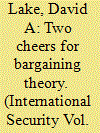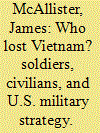|
|
|
Sort Order |
|
|
|
Items / Page
|
|
|
|
|
|
|
| Srl | Item |
| 1 |
ID:
101887


|
|
|
|
|
| Publication |
2011.
|
| Summary/Abstract |
Cost distribution theory suggests that the costs to the median voter in a democracy of fighting an insurgency with firepower are relatively low compared to a more labor-intensive approach. Therefore, this voter will favor a capitalintensive counterinsurgency campaign despite the resulting diminished prospects of victory. Primary and secondary sources show that President Lyndon Johnson and his civilian aides were very much aware that, although they considered a main force-focused and firepower-intensive strategy to be largely ineffective against the insurgency in South Vietnam, it was politically more popular in the United States. Importantly, civil-military agreement on warfighting strategy does not undermine this explanation, which assumes that civilian leaders, and ultimately the public, play an essential role in that strategy's determination. Appointing and supporting Gen. William Westmoreland was just one means by which the Johnson administration ensured that the U.S. military emphasized the fight against conventional enemy units and relied on the use of firepower for the fight against Vietcong insurgents. Civil-military disagreements over strategy, however rare, therefore provide the essential test of cost distribution theory's explanatory power. When officials suggested that the U.S. military adopt more labor-intensive pacification approaches to fight the insurgency, the Johnson administration rejected them.
|
|
|
|
|
|
|
|
|
|
|
|
|
|
|
|
| 2 |
ID:
101889


|
|
|
| 3 |
ID:
101885


|
|
|
|
|
| Publication |
2011.
|
| Summary/Abstract |
Why has transnational war volunteering increased so dramatically in the Muslim world since 1980? Standard explanations, which emphasize U.S.-Saudi support for the 1980s Afghan mujahideen, the growth of Islamism, or the spread of Wahhabism are insufficient. The increase in transnational war volunteering is better explained as the product of a pan-Islamic identity movement that grew strong in the 1970s Arab world from elite competition among exiled Islamists in international Islamic organizations and Muslim regimes. Seeking political relevance and increased budgets, Hijaz-based international activists propagated an alarmist discourse about external threats to the Muslim nation and established a global network of Islamic charities. This "soft" pan-Islamic discourse and network enabled Arabs invested in the 1980s Afghanistan war to recruit fighters in the name of inter-Muslim solidarity. The Arab-Afghan mobilization in turn produced a foreign fighter movement that still exists today, as a phenomenon partly distinct from al-Qaida. The analysis relies on a new data set on foreign fighter mobilizations, rare sources in Arabic, and interviews with former activists.
|
|
|
|
|
|
|
|
|
|
|
|
|
|
|
|
| 4 |
ID:
101888


|
|
|
|
|
| Publication |
2011.
|
| Summary/Abstract |
Despite the ubiquity of the term "alliance of convenience," the dynamics of these especially tenuous alliances have not been systematically explored by scholars or policymakers. An alliance of convenience is the initiation of security cooperation between ideological and geopolitical adversaries in response to an overarching third-party threat; they are conceptually different from other types of alliances. Neorealist, two-level games, and neoclassical realist theories all seek to explain the outcome of intra-alliance bargaining between the United States and allies of convenience since 1945. Neorealism and two-level games theories broadly predict successful U.S. bargaining because of the United States' favorable position in the international system and the relatively tight constraints on executive power in the United States, respectively. By contrast, neoclassical realism predicts that tight constraints on executive power in the United States should have led the foreign policy executive to bargain unsuccessfully with allies of convenience. In the case of the U.S. alliance of convenience with Iraq during the 1980-88 Iran-Iraq War, neoclassical realism best explains the outcome of U.S. bargaining with Iraq. This case has implications for other U.S. bargaining efforts.
|
|
|
|
|
|
|
|
|
|
|
|
|
|
|
|
| 5 |
ID:
101884


|
|
|
|
|
| Publication |
2011.
|
| Summary/Abstract |
The Iraq War has received little sustained analysis from scholars of international relations. I assess the rationalist approach to war-or, simply, bargaining theory-as one possible explanation of the conflict. Bargaining theory correctly directs attention to the inherently strategic nature of all wars. It also highlights problems of credible commitment and asymmetric information that lead conflicts of interest, ubiquitous in international relations, to turn violent. These strategic interactions were central to the outbreak of the Iraq War in 2003. Nonetheless, bargaining theory is inadequate as an explanation of the Iraq War. Although the problem of credible commitment was real, it could not be solved because of the prior beliefs of the Bush administration that Saddam Hussein was uniquely evil and because of Saddam's inability to signal accurately to multiple audiences, both factors now outside bargaining theory. Nor was the problem of private information an important impediment to bargaining; rather, the information failures observed in both Washington and Baghdad were of their own making as each formed self-deluding beliefs and expectations. Bargaining theory also ignores postwar governance costs and domestic interest groups, both of which contributed to the war. All of these problems require either considerable amendments to the theory or the revision of core assumptions. Drawing on this critique, the final sections draw out the analytic and policy lessons of the Iraq War and suggest, most importantly, the need for a new behavioral theory of war.
|
|
|
|
|
|
|
|
|
|
|
|
|
|
|
|
| 6 |
ID:
101886


|
|
|
|
|
| Publication |
2011.
|
| Summary/Abstract |
Scholars have long argued about why the United States pursued a conventional military strategy during the Vietnam War rather than one based on counterinsurgency principles. A recent article in this journal by Jonathan Caverley presents a bold challenge to the historiography of the Vietnam War. Rejecting the standard historical focus on the organizational culture and strategic perspective of Gen. William Westmoreland and the U.S. Army, Caverley argues that the roots of the United States' strategy in Vietnam can be traced to the direct influence of civilian leaders and the strong constraint of public opinion. Caverley's main arguments are a welcome challenge to the established wisdom, but they are not supported by the historical evidence. Civilian officials in Lyndon Johnson's administration did not instruct the military on how to fight the ground war within the borders of South Vietnam. Westmoreland did not want to change U.S. military strategy to focus on pacification at the expense of search and destroy tactics and the main force war. Both U.S. civilian and military officials were convinced that counterinsurgency was a South Vietnamese responsibility that U.S. ground forces should not assume. Public opinion was a weak, rather than a strong, constraint on the specific decisions of the Johnson administration during the pivotal years of the Vietnam War. Democracies may not be able to win certain counterinsurgency conflicts, but the primary source of this failure is not a civilian aversion to casualties.
|
|
|
|
|
|
|
|
|
|
|
|
|
|
|
|
|
|
|
|
|